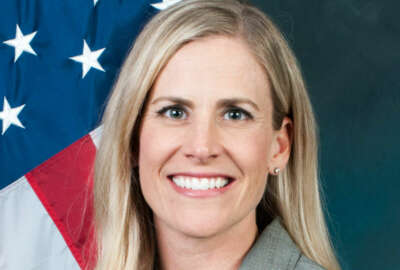
How the Treasury Department plays whack-a-mole with financial weaknesses
The Government Accountability Office says the Treasury Department has made good progress on some deficiencies on financial statements, but new ones have popped up.
Best listening experience is on Chrome, Firefox or Safari. Subscribe to Federal Drive’s daily audio interviews on Apple Podcasts or PodcastOne.
The larger the budgets and deficits seem to grow, the more elusive, auditable financial statements of the federal finances seem to get. The Government Accountability Office says the Treasury Department has made good progress on some deficiencies, but new ones have popped up. The Federal Drive with Tom Temin gets the latest from GAO’s director of financial management and assurance issues, Dawn Simpson.
Interview transcript:
Tom Temin: And this gets back to a perennial issue for GAO, which is trying to audit the consolidated statements of the federal government. And in general, it’s fair to say GAO is never able to render a judgment because of these deficiencies. Just remind us on the background here.
Dawn Simpson: We’ve been auditing the U.S. government’s consolidated financial statements since fiscal year 1997. And we have not been able to provide an opinion on the consolidated financial statements related to the accrual-based financial statements. And in part that’s due to material weaknesses and internal control. Three of which of those material weaknesses do relate to the processes that the Department of the Treasury in coordination with the Office of Management and Budget use to prepare the consolidated financial statements.
Tom Temin: And which part of Treasury actually does this? Is it the Bureau of the Fiscal Service?
Dawn Simpson: Yes, primarily the Bureau of the Fiscal Service, with also some pieces of the Office of Fiscal Assistant Secretary and then in coordination with the Office of Management and Budget.
Tom Temin: And in layman’s terms, that is non-CPA terms, what are these deficiencies? And how do they relate to the ability to say yes, this is right or not right, when it comes to the rolling up the whole statement?
Dawn Simpson: So as I mentioned, there are three material weaknesses and internal control related to these processes that are used to prepare the statements. One of the material weaknesses deals with the transactions that occur between federal entities, and in the federal government. There are many, many transactions that occur between federal entities, and the problem is, those transactions per federal accounting standards needs to eliminate in order to prepare the consolidated financial statements, and that is not effectively happening. There is, you know, a significant amount of those intergovernmental transactions that are not properly eliminating and consolidation. The second material weakness is the preparation process itself, that the Department of Treasury in coordination with Office of Management and Budget views and the issues that are within this preparation, material weakness deal with that. The statements do not currently balance, and that goes back primarily to the first deficiency I was talking about with all the transactions not eliminating between federal entities. Well, the result of that is then the statements themselves do not properly balance and so Treasury has to record a plug in order to get everything to work out. And then in addition to that, as far as ensuring that the financial statements are in accordance with generally accepted accounting principles, that is also one of the issues. And then the third, material weakness relates to two statements that are prepared only at the consolidated level. And these statements show the reconciliation between the budget deficit and changes in cash, as well as the reconciling items between net cost and the budget deficit. And we have found that Treasury’s process for preparing these two financial statements is not effective as far as identifying all the reconciling items that should be included, as well as the consistency with the underlying agency level information.
Tom Temin: And you mentioned though, in this latest report, the latest update on all of this, that the Treasury has made progress in a number of other deficiencies that had been long standing.
Dawn Simpson: we have found significant progress by the Department of Treasury and the Office of Management and Budget, specifically over the last few years. I mean, when you think back to that, we’ve been auditing the financial statements since fiscal year 1997. We’ve made over 260 recommendations throughout our audit related to the processes for preparing the consolidated financial statements. And so over these years Treasury and the Office of Management and Budget, as well as the agencies that are providing the amounts for Treasury to consolidate, have made significant improvements in their financial reporting. And we continue to see them this past year as it relates to the Department of Treasury in the efforts that they’re undertaking, we were able to close two recommendations. So there’s only currently 10 recommendations now open from prior years plus, we made five new recommendations that we just issued. But of those 10, even though those remain open, we found that Treasury made significant progress in implementing their corrective actions related to those prior year recommendations.
Tom Temin: We’re speaking with Dawn Simpson, director of financial management and assurance issues at the Government Accountability Office. And the report also said there were four new deficiencies that popped up this year. Just briefly describe what those are. And I guess your recommendations are to fix those.
Dawn Simpson: Treasury has many procedures and processes for preparing the consolidated financial statements. And so we found that well, Treasury had policies and procedures in these specific areas for these four new deficiencies relate to, we found that their procedures were not sufficient. And so they could make improvements in these areas. And these areas related to the accounting or reporting for significant unusual transactions that could occur. And so one example of that would be if like new legislation was introduced during the year, the second one related to the identification and analysis of all uncorrected misstatements that could be included in the consolidated financial statements. The third one related to properly disclosing the significant accounting policies that are used to prepare the statements. And then the fourth one related to better documenting disclosure decisions that Treasury made both as far as disclosures that were made, as well as decisions on disclosures to not make. And so well, Treasury has procedures in all these areas, we found that those procedures needed to be improved.
Tom Temin: Alright, and let me just ask you a kind of philosophical question. If someone were to be, say, a corporate tax accounting, or an accounting type of person, or an auditor, that looks at corporate accounting, and make sure that it’s all kosher. If such an expert were to join Treasury and look at the way the federal government goes about accounting for itself and creating balance sheets and consolidated statements, would it look to that person like they were on Mars? Or is there some correspondence between the way the government accounts for itself, and it requires private publicly held industry, or all industry for that matter to account for itself?
Dawn Simpson: So there would be a lot of similarities because you are consolidating information per accounting standards, to develop financial statements, and that same financial statements that the federal government has, when you think of the balance sheet, I mean, that’s consistent across all entities, whether your government or not. And so there are certain aspects that are very similar. The challenge is with the federal government, there’s over 160 reporting entities that are part of the federal government that then submit data for this consolidation process, and just the complexities and quantity of data that has been coming into the Department of Treasury to then consolidate the information, ensure its consistency, and then do what is needed, at the consolidated level, such as eliminating and transactions between federal entities that I was mentioning earlier. It’s a very challenging aspect, given the size and complexity of the U.S. government.
Tom Temin: And GAO has been finding these deficiencies and Treasury has been sounds like trying to nail them down, and they generally agree with them. Do you have the sense that at some point, GAO will be able to offer an opinion on what it sees as sound financial statements?
Dawn Simpson: Well, that is the goal. And like I said, we have seen a significant amount of progress in being able to see improvements in federal financial management over the year. When you think back to those first audits at the agency level that were done in 1996 for the fiscal year 1996 financial statements. Six of the 24 chief financial officers act agencies, only six were able to get clean opinions on their financial statements. And this past year, we were at, you know, 21 to 22, these last few years of agencies that are able to to get a clean opinion. So there’s been a huge amount of progress in the audit of the individual agency financial statements. And we are continuing to see a lot of progress, as we were just talking about at the consolidated level. And so yes, that commitment by the Department of Treasury, Office of Management and Budget, as well as the agencies, that strong commitment that we’ve really been seeing here these last few years, that continued commitment by them, then hopefully, we will get to the gold. Audited, clean, consolidated financial statements.
Tom Temin: All right, well, we’ll pop some champagne on the day that happens. Dawn Simpson is director of financial management and assurance issues at the GAO.
Copyright © 2025 Federal News Network. All rights reserved. This website is not intended for users located within the European Economic Area.
Tom Temin is host of the Federal Drive and has been providing insight on federal technology and management issues for more than 30 years.
Follow @tteminWFED
Related Stories





